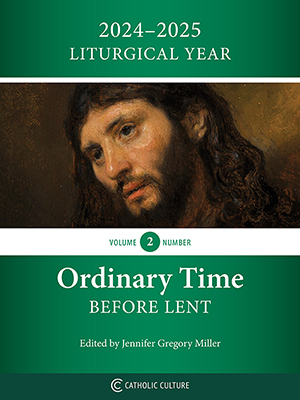Tolkien the modernist: a glimpse of a unique creative process
By Thomas V. Mirus ( bio - articles - email ) | Feb 14, 2017 | In Reviews
[My work is] fundamentally linguistic in inspiration…The invention of languages is the foundation. The ‘stories’ were made rather to provide a world for the languages than the reverse. To me a name comes first and the story follows.
Free eBook:

Free eBook: Liturgical Year 2024-2025, Vol. 2
That Tolkien’s creative work began with his invention of languages is well known, but the full degree to which his stories are informed by his work as a philologist, and vice versa, is less appreciated.
Immediately after returning from World War I, Tolkien took a job as an assistant on the Oxford English Dictionary (mainly working on the etymologies of a set of words beginning with “w”). He would later say, “I learned more in those two years than in any equal period of my life.” If Tolkien’s work was “fundamentally linguistic in inspiration,” then his time at the OED and its influence on his work is an essential part of Tolkien scholarship. Many scholars have indeed touched on it, but not until 2006 was a book devoted solely to the subject: The Ring of Words: Tolkien and the Oxford English Dictionary, by Peter Gilliver, Jeremy Marshall and Edmund Weiner.
The book is even more fascinating than I expected. The Ring of Words is divided into three sections: an account of Tolkien’s time and duties at the OED (detailing his work on words such as warm, walnut, wick, wold, etc.); an examination of the philological aspects of Tolkien’s creativity and the creative aspects of the discipline of philology; and, taking up over half the book, individual studies of words invented, revived or put to new uses by Tolkien (like hobbit, eucatastrophe, wight, Thain, sigaldry). The second section, “Tolkien as Wordwright,” was for me the most illuminating.
Philology as imaginative work, fiction as philology
Unlike the modern-day discipline of linguistics by which it has been all but displaced, philology is not just the study of languages but of the literary, social and historical contexts in which those languages developed. The etymology of a single word can tell us quite a bit about past cultures. The authors of The Ring of Words use as an example one of Tolkien’s own etymologies in the OED, for walnut, which explains among other things that the first element of this word meant ‘Celtic or Roman foreigner,’ as in the name Wales, and that the ordinary word in Romance languages for nut when unmodified meant a walnut whereas the ordinary word for nut in Germanic languages meant a hazelnut:
This etymology takes us back to the time of the Roman Empire, when walnuts were relatively exotic items for the Germanic peoples, and when foreigners living to the west and south of the Germanic realms were indiscriminately called by a word which in English has become the word Welsh.
Etymology inevitably involves reconstruction similar to that done in paleontology or studies of evolution. The philologist may speculate about a vanished word that may have been a common ancestor for two extant words sharing a similar element. At other times a word may appear in very old texts and then disappear for a few centuries before reemerging in new forms, in which case the philologist may speculate that at one time an intermediary form existed which does not survive in any extant texts.
What is important here is that philology is an inherently imaginative and creative as well as scientific discipline. As the dean of Tolkien scholars, Tom Shippey, suggested in The Road to Middle-Earth, the reconstruction of a lost word involves on some level the recreation of a lost history, even of a lost world. This is why Tolkien’s work as a philologist could be so completely integrated into his work as a creative writer.
His fictional subcreation was, in its early stages, an attempt to create a mythology for England, though he soon abandoned this concept. More fundamentally, it came from his passion for inventing languages, and his desire to “discover” the history and world, the migrations and cultural shifts, in which and by which those languages, primarily the Elvish tongues, had developed (though this complete history, The Silmarillion, was not published in his lifetime). In short, he applied to his own invented languages exactly the philological methods he had used in his work on real-world language in his work at the OED.
Tolkien also frequently took ancient real-world words as creative inspiration, while giving them quite new meanings. The obscure Old English word ent means a giant or mighty person of old; all the ancient works were said to have been built by giants. Tolkien wrote that this word was the inspiration for the giant tree-like creatures of Middle-Earth. He also remarked that he liked the resonance with the Latin philosophical word ens, meaning essential being.
But looking closer at the history of this Old English word, there is still more resonance with the use of the Ents in Tolkien’s story. One occurence of the word is in the phrase orthanc enta geweorc, “the cunning work of giants,” and this is the origin of the name of Orthanc, the ancient tower in which Saruman (whose own name means “man of skill” or “the one of cunning devices”!) dwells, which is ultimately besieged and overthrown by the Ents. Another possible connection emerges when we learn that a Christian legend referenced in the 13th-century Lambeth Homilies had the Tower of Babel built by giants after the Flood. The Ents destroyed the fortress of the arrogant Saruman by flooding it: the story is different but the association of giants with a flood and a tower that falls as a result of pride remains, mixed up in much the way we might expect to happen to the elements of a mostly-forgotten legend.
Tolkien’s use of archaism
One of the most valuable contributions of The Ring of Words is to set Tolkien in the context of a pre-existing literary tradition which, starting in the late 18th century, took inspiration from philology, folklore, medieval literature and Germanic legends. In particular, Tolkien was not the first to revive old words or to use “period language”—archaic words and word forms—to create a sense of ancientry or grandeur.
Authors like George Dasent (1817-1896) felt that reviving Old English words or creating new Germanic words was more authentic for English literature than using Latinate or French loan-words; Dasent coined the word “foreword” as a more truly English alternative to “preface.” Sir Walter Scott (1771-1832), Dasent, and Lord Macaulay (1800-1859), and many others borrowed words from Malory and Chaucer for their own romantic tales. However, these writers were sprinklers, often mixing contemporary and archaic language together in an inconsistent and distracting manner.
William Morris (1834-1896) was more complete in his appropriation of this language, creating a thoroughly archaic style which greatly influenced Tolkien’s early, unpublished legends. But Tolkien quickly evolved in his use of archaism in two ways. First, he learned to restrain it in such a way as to create a heightened atmosphere without sacrificing readability; in his own words, he developed “a form of language familiar in meaning and yet freed from trivial associations, and filled with the memory of good and evil.”
Second, by the time of The Lord of the Rings, archaism was just one tool in Tolkien’s belt. When one hears complaints about his allegedly constant use of heightened, archaic or even bombastic language, one wonders (as with so many other criticisms) if the accusers have read his work with any degree of attention; a close reading shows that he modulated his language carefully according to the needs of the sentence, paragraph or scene. Scenes in the Shire, for example, are in contemporary English, even using slang, while more heroic events are heightened with archaic language and diction. But (to use an example cited in The Ring of Words) when, at the end of the novel, the hobbits return to the Shire as heroes, there is a new potential for such language to emerge at times:
The silver and sable of Gondor gleamed on [Pippin] as he rode forward. “I am a messenger of the King,” he said. “You are speaking to the King’s friend, and one of the most renowned in all the lands of the West. You are a ruffian and a fool. Down on your knees in the road and ask pardon, or I will set this troll’s bane in you!” The sword glinted in the westering sun.
Suffice it to say that Tolkien, as the greatest living expert on the English language, knew the effects and connotations of the words he was using, and chose each one carefully.
It is hard to think of any other fiction author in whom art and scholarship were so completely united. As scholars like Tom Shippey have noted, the philological aspects (among other features) of Tolkien’s fiction are a part of what makes him not just one of the greatest novelists of the twentieth century, but also a distinctly modern writer.
While Tolkien is usually thought of as a medievalist proudly out of step with his own time, one thing that can be said about medievalists is that they can never be medievals. Tolkien was not and could not have been just an imitator of medieval literature; he viewed it both with a deep sympathy and with a scholarly detachment. This reflected itself not just in his creative methods but in their results. He envisioned his tales not merely as ancient legends in their original form, but as they had been transmitted over centuries and finally “translated” and “adapted” by a modern recipient. His use of metanarrative in his linguistic histories and, beyond the scope of this article, in the fake text tradition in which he framed his stories—a game no one could have conceived of prior to modern textual and historical criticism—show him to be not just a modern writer, but even a true literary modernist.
Editor’s note: In literature, a modernist is a writer who deliberately breaks with established literary forms and/or subjects in both prose and poetry. Modernism is also the name of a literary period in which this sort of experimentation was very common, usually associated with the early to mid-twentieth century. Many of these writers broke with tradition in other ways as well, such as embracing individualism and relativism. Tolkien’s modernism, however, was deeply Catholic. In the philosophical sense, it was already a step ahead, breaking with the growing relativism of his generation.
All comments are moderated. To lighten our editing burden, only current donors are allowed to Sound Off. If you are a current donor, log in to see the comment form; otherwise please support our work, and Sound Off!







